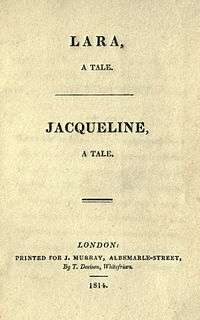Lara, A Tale

| Wikisource has original text related to this article: |
Lara, A Tale is a rhymed, tragic narrative poem by Lord Byron; first published in 1814.
Background
The first work composed after Byron abandoned the idea of giving up writing and buying back his copyrights, it is regarded by critics as a continuation of the autobiographical work begun in The Corsair.[1] Unlike The Corsair, it was published anonymously, in conjunction with Samuel Rogers' Jacqueline.[2]
Lara, A Tale was first published anonymously by Lord Byron in 1814 alongside another poem that was not written by Byron. In this version, there is nothing to distinguish between Lara and Jacqueline (written by Samuel Rogers), as they were published anonymously and without any indication that there are two separate authors within the text. This tragic narrative poem is seen as a continuation of another poem of Byron’s, The Corsair. It details Count Lara’s return home after spending a few years travelling abroad. With a page as his only company, Lara’s story continues as he encounters problems with his fellow men. First, this leads to a duel that Count Lara ends up winning and as the story progresses, he must also fight both friends and foes. Count Lara is successful in his battle against all odds, until one night he encounters a large group and attempts to fight them. Unfortunately, he is mortally wounded in the process and dies at the end of the poem.
The first drafts of the poem are from 1814. The copy text that Byron wrote for the first edition was made between June 14 and June 23, 1814. There were subsequent corrections made but none of the materials have been found. Sometime after August 5, 1814, Lara was published with Jacqueline for the first time. The first three editions were published together and anonymously, selling almost 7,000 copies. When the fourth edition was released, the tale was published by itself and under Byron’s name.
Summary
The narrative poem recounts the story of the fateful return of Count Lara to his home after spending years abroad traveling the orient. One of Byron's footnotes explains that, even though the name "Lara" is of Spanish origin, "no circumstance of local or national description fix[es] the scene or hero of the poem to any country or age". [3]
Returning to his patrimony with a retinue consisting of one foreign-born page, Kaled, Count Lara resumes the management of his landed estates. Lara's first efforts are crowned with success: only to be undermined by the jealousy and envy of his peers. After a successful duel to defend his honour, the count becomes inexorably caught up in local blood-feuds; which quickly escalate to open warfare between his own followers and the private armies of his enemies.[4]
Fighting against insuperable odds with desperate courage, Count Lara rallies the remnant of his shattered forces and makes for the border to regroup. During a forced night march he is intercepted by a large opposing force: and in the course of the ensuing battle he is mortally wounded, and is retired from the fighting due to the good offices of his ever-faithful oriental page.
As Count Lara lies dying he is confronted by his nemesis, Count Otho, but ignores the latter's taunts to address his dying words to his page in a foreign tongue unknown to his countrymen. Otho arranges the obsequies, but Count Lara's page refuses to desert the graveside, his grief rendering him immune to Otho's threats and pleas not to abandon his former master.[5]
References
- ↑ Byron, George Gordon; Lara; The Siege of Corinth; Parisina; The Prisoner of Chillon; The Dream Kessinger publications reprint 2004, editor's notes p16
- ↑ London Quarterly Review Vol. 11 1814
- ↑ Byron, George, Gordon. "Lara." The Corsair and Lara. Ed. Peter Cochran. 2009. 52-85. p.52. https://petercochran.files.wordpress.com/2009/03/the_corsair_and_lara.pdf
- ↑ Byron, George Gordon. The Poems of Lord Byron. London: Oxford University Press, 1945. pp. 303-319.
- ↑ Byron, George Gordon. The Poems of Lord Byron. London: Oxford University Press, 1945. pp. 318-319.
External links
| Wikisource has the text of the 1905 New International Encyclopedia article Lara. |
- Lara, A Tale, full text at the Internet Archive

.jpg)